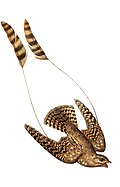Eleothreptus
Appearance
| Eleothreptus | |
|---|---|

| |
| White-winged nightjar (Eleothreptus candicans) | |
| Scientific classification | |
| Kingdom: | Animalia |
| Phylum: | Chordata |
| Class: | Aves |
| Clade: | Strisores |
| Order: | Caprimulgiformes |
| Family: | Caprimulgidae |
| Genus: | Eleothreptus Gray, GR, 1840 |
| Type species | |
| Amblypterus anomalus Gould, 1838
| |
Eleothreptus is a genus of South American nightjars in the nightjar family Caprimulgidae.
Taxonomy
[edit]The genus Eleothreptus was introduced in 1840 by the English zoologist George Gray with Amblypterus anomalus Gould, 1838, the sickle-winged nightjar, as the type species.[1] Eleothreptus was a replacement name for Amblypterus that had been used by Louis Agassiz in 1833 for a genus of fossil fishes.[2] The genus name is from Ancient Greek ἑλεοθρεπτος/heleothreptos meaning "marsh-bred" from ἑλος/helos, ἑλεος/heleos meaning "marsh" and τρεφω/trephō meaning "to nourish".[3]
The genus contains the following two species:[4]
- Sickle-winged nightjar (Eleothreptus anomalus)
- White-winged nightjar (Eleothreptus candicans)
References
[edit]- ^ Gray, George Robert (1840). A List of the Genera of Birds : with an Indication of the Typical Species of Each Genus. London: R. and J.E. Taylor. p. 7.
- ^ Peters, James Lee, ed. (1940). Check-List of Birds of the World. Vol. 4. Cambridge, Massachusetts: Harvard University Press. p. 220.
- ^ Jobling, James A. "Eleothreptus". The Key to Scientific Names. Cornell Lab of Ornithology. Retrieved 24 June 2025.
- ^ Gill, Frank; Donsker, David; Rasmussen, Pamela, eds. (February 2025). "Frogmouths, Oilbird, potoos, nightjars". IOC World Bird List Version 15.1. International Ornithologists' Union. Retrieved 24 June 2025.







